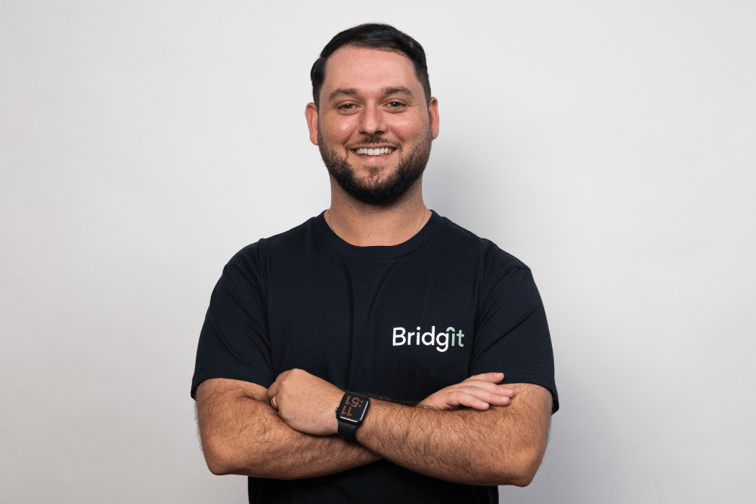

As interest rates continue to rise and traditional lenders struggle to cope with the dynamic change in the loan market, one non-bank has pledged its assistance to borrowers.
Bridgit specialises in bridging loans and offering same-day approval to consumers through proprietary technology, as well as assisting homeowners looking to purchase their next property quickly and seamlessly.
The non-bank lender’s CEO and co-founder, Aaron Bassin (pictured above), said in September inflation reached its highest level since the early 1990s, so it came as no surprise when the Reserve Bank raised interest rates to help contain upward financial pressure.
“For hundreds of thousands of Australians, this means a higher cost of borrowing and a rise in living expenses – as a result, more and more homeowners are looking outside traditional lending and towards non-banks,” Bassin said.
“According to the PEXA Mortgage Insights Report for Financial Year 2022, non-bank lenders dominated the market in 2021 and this continued rise is in part due to their product diversity and specialisation of a market niche, making them a viable alternative to the traditional home loan.”
Non-bank lenders can provide finance quickly
Bassin said speed matters when it comes to a hot property market like Australia’s.
“Traditional lenders are often encumbered by long wait times due to manual process with loan approvals taking up to eight weeks to process which means delays and less certainty for borrowers,” he said.
“For some buyers, this means missing out on buying their dream property because they couldn’t get their loan approved in time. The new breed of non-bank lenders is built around fast decision-making and quick turnaround times because they understand that in today’s competitive environment, it’s more important than ever to act fast on property decisions.”
Flexibility is attractive
Bassin said the way Australians bought and sold property had changed.
“A few decades ago, the average borrower would take out a mortgage on a family home and pay it off over 30 years, however today we are buying and selling more often as we seek the right property to suit our changing lifestyles, from a growing family upsizing for rooms and backyard space, to investors looking to flip houses or add to their portfolios,” he said.
“One growing market segment is the downsizer – this is typically a baby boomer whose adult children have left and who wants to sell their large family home to buy something smaller in keeping with their retirement plans. The challenge for this type of homeowner is that there’s a gap between being quick to buy their next home and exercising patience by letting their existing property take longer to sell or settle to attain their ideal asking price.”
Bassin said the other challenge for baby boomers was securing a short-term loan or a bridging loan with a traditional lender.
“The entire process can be tedious, time consuming, or in some cases the loan may not even be approved,” he said.
Downsizers should look for a non-bank lender that provides a range of flexible options such as bridging finance, Bassin said.
This would help them avoid managing two simultaneous mortgages and bypass the extra costs of temporary living during the buying and selling period.
“Rather than capitalising on built-up interest over decades, a non-bank lender has loan products designed to help homeowners pay off their loan as soon as possible so you progress instead of spending years holding onto the loan.”
Borrowers come in all shapes
Bassin said alongside changes in the way Australians purchased property, the range of borrowers looking for funding had also changed.
“Gone are the days when the bulk of mortgagees are workers with a steady nine-to-five job,” he said.
“In many cases, there are homeowners who don’t fit the traditional mould lenders prefer. These homeowners are looking to access their untapped wealth through property equity but may be self-employed or retired – two segments rarely supported by traditional lenders and big banks. This is where alternate solutions and lenders come in.”
Bassin said non-banks still do due diligence on their customers and have less restrictive criteria for loans, removing the traditional barriers that prevent self-employed and retired borrowers from accessing suitable property financing.
“As interest rates push upwards and market forces challenge homeowners, non-bank lenders have come to the forefront to offer fast, flexible and accessible loans for borrowers navigating the dynamic property sector. If a traditional home loan can’t meet your needs, there’s likely a non-bank lender who can.”
In November, Bridgit announced it was joining leading aggregator Finsure's panel as its first tech-driven bridging finance solution.
"Finsure was aligned with our mission to provide brokers and Australian homeowners better solutions through the use of technology,” Bassin said.
“They understood the problem we are solving with our bridging solution and saw the value this could provide to their network. Finsure are committed to education, compliance and brilliant service with their client base, which aligns with our business values, so it was a no brainer to enter into a partnership."
What do you think about the rise in popularity of non-bank lenders? Let us know in the comments below.
